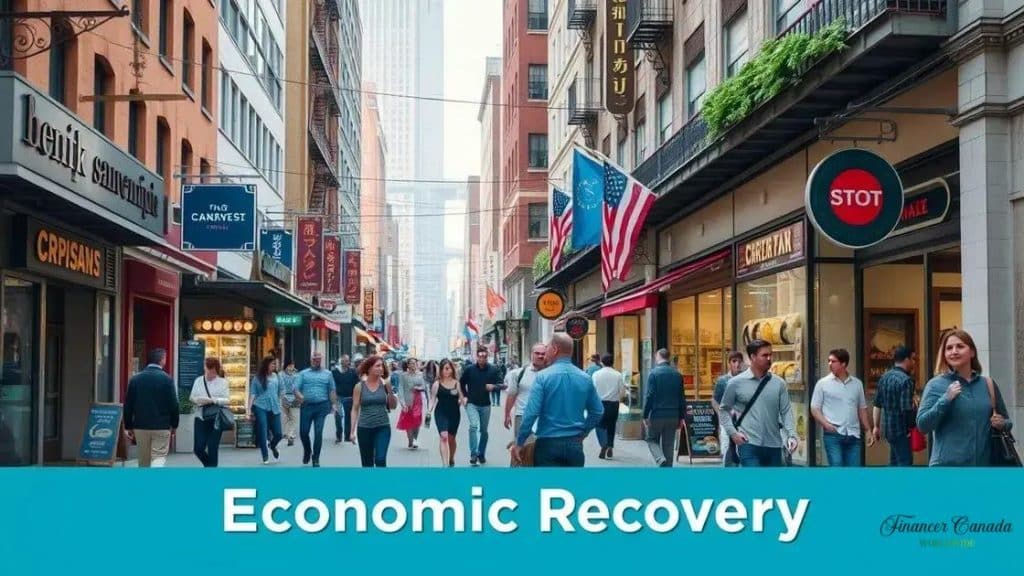Global economic recovery after COVID-19: what to expect

The global economic recovery after COVID-19 is driven by key sectors like technology and green energy, supported by government policies and digital transformation efforts.
Global economic recovery after COVID-19 is on everyone’s mind as nations seek to bounce back. Have you wondered how this recovery will shape your daily life and business prospects? Let’s dive into what lies ahead.
Analyzing the impact of COVID-19 on global economies
The global economy faced unprecedented challenges due to COVID-19. Understanding the impact of the pandemic is crucial for identifying recovery paths. It not only disrupted supply chains but also reshaped consumer behavior.
Immediate Effects on Economies
Initially, lockdowns resulted in a sharp decline in economic activity worldwide. Businesses struggled, leading to significant job losses. Many sectors experienced drastic downturns, especially travel, hospitality, and retail.
Long-term Economic Changes
While some effects were immediate, others are likely to influence the global economy for years. Companies have had to adapt to new ways of operating. For instance, remote work is now more prevalent.
- Increased reliance on technology
- Shifts in consumer spending habits
- Emergence of new industries
These trends signal a transformation in how businesses will function moving forward. Economists project that nations that embrace these changes may recover more swiftly.
Sector-Specific Impacts
Some sectors have shown resilience despite the odds. For example, the technology sector boomed as demand for digital solutions skyrocketed. In contrast, traditional brick-and-mortar stores have struggled to stay afloat without a digital presence.
It’s essential for both policymakers and businesses to focus on adaptation strategies. By understanding these trends, we can better navigate the post-pandemic landscape. Awareness of COVID-19’s economic impact leads to smarter decisions that can bolster recovery efforts.
Key sectors driving the recovery

Identifying the key sectors driving the recovery after COVID-19 is essential for understanding where growth will occur. Some industries have shown incredible resilience and adaptability in the face of challenges.
Healthcare Sector
The healthcare sector dramatically transformed during the pandemic, evolving to meet urgent needs. Telemedicine became mainstream, allowing patients to access care remotely. This shift has not only improved healthcare delivery but has also opened doors for innovations.
Technology and E-commerce
Technology companies have thrived, as more people turned to digital solutions. E-commerce has exploded, with consumers increasingly opting for online shopping. This change represents a new norm in consumer behavior.
- Rise of cloud computing
- Expansion of delivery services
- Growth in online education
The pivot to digital platforms indicates a lasting trend that will shape the economy. Another notable sector is green energy, which is receiving renewed attention.
Green Energy Initiatives
Amid recovery efforts, governments are focusing on sustainable practices. Investments in renewable energy sources like solar and wind power are on the rise. This movement aims to create jobs while addressing climate change.
Additionally, the construction sector is adapting, with new regulations promoting sustainability in building practices. These shifts are paving the way for a cleaner, more resilient economy.
Government policies enhancing economic stability
Government policies play a vital role in enhancing economic stability following the disruptions caused by COVID-19. Various strategies are being implemented to support both businesses and individuals during this recovery phase.
Fiscal Stimulus Packages
One major response has been the introduction of fiscal stimulus packages. These packages provide financial assistance to struggling sectors and individuals. By injecting money into the economy, governments aim to spur growth and create jobs.
Monetary Policy Adjustments
Central banks have also adjusted their monetary policies to ensure liquidity in the market. Lowering interest rates allows easier access to credit for businesses and consumers alike, encouraging spending and investment.
- Implementation of low-interest loans
- Support for small businesses
- Tax relief measures
Such approaches are essential for driving short-term recovery while aiming for long-term economic health.
Support for Employment
Another significant focus has been on supporting employment through various programs. For instance, governments have introduced job retention schemes that prevent layoffs and provide financial aid to employers. This support helps maintain workforce stability as the economy adjusts.
Additionally, training programs are being established to help workers transition into growing industries. This ensures that employees adapt to the changing job market post-pandemic.
The role of technology in economic recovery

The role of technology in economic recovery has become increasingly significant in a post-COVID-19 world. As businesses adapt to new consumer behaviors, technology has emerged as a crucial driver of innovation and efficiency.
Digital Transformation
Many companies accelerated their digital transformation efforts during the pandemic. This shift includes adopting online platforms for sales, communication, and customer service. Such changes allow businesses to reach wider audiences while maintaining safety measures.
Remote Work Technologies
With the rise of remote work, technology has enabled employees to stay productive from home. Tools like video conferencing and project management software have become essential for teams to collaborate effectively.
- Increased use of cloud computing
- Expansion of cybersecurity measures
- Growth of telecommuting platforms
This shift has shown that flexibility in the workplace can enhance overall productivity. Furthermore, technology supports the development of new business models that can thrive in changing environments.
Innovations in Health and Safety
Technological advancements also play a critical role in ensuring health and safety. Solutions like contactless payment systems and health tracking apps have become popular, minimizing health risks. Such innovations are pivotal in building consumer trust as economies reopen.
As we move forward, the integration of technology will continue to redefine economic landscapes. Businesses that embrace these changes will likely be better positioned for sustainable growth.
Future trends in the global economy
Understanding the future trends in the global economy is vital as the world shifts post-COVID-19. Several emerging patterns indicate how economies may evolve over the next few years.
Sustainability and Green Initiatives
One prominent trend is the increasing focus on sustainability. Businesses and governments are prioritizing eco-friendly practices. From renewable energy sources to green technology, investments are rising in this area.
Digital Transformation
As seen during the pandemic, digital transformation is here to stay. Companies that embrace technology will thrive in the future. E-commerce, artificial intelligence, and automation are reshaping industries.
- Expansion of remote work
- Growth of online education
- Increased reliance on e-commerce
The speed of these changes suggests a permanent shift in how businesses operate. Companies that adapt quickly will gain a competitive edge.
Global Supply Chain Resilience
The pandemic exposed vulnerabilities in global supply chains. As a result, businesses are looking to build more resilient systems. Local sourcing and diversified supply chains are becoming essential strategies.
Furthermore, geopolitical factors will also shape economic relationships. Countries will reassess their dependencies on certain markets, leading to new trade partnerships.
The emergence of these trends suggests an exciting yet challenging future for the global economy. By staying informed, businesses and individuals can prepare for what’s ahead.
FAQ – Frequently Asked Questions about Global Economic Recovery
What are the key sectors driving global economic recovery?
The key sectors include technology and green energy, which are essential for sustainable growth and innovation.
How do government policies impact economic stability?
Government policies provide necessary support to businesses and individuals, ensuring a stable recovery environment.
What role does technology play in the post-COVID-19 economy?
Technology facilitates digital transformation, enhances remote work, and improves access to services, driving economic recovery.
What are some future trends we can expect in the global economy?
Expect a focus on sustainability, resilience in supply chains, and increased reliance on digital solutions as prevalent future trends.





